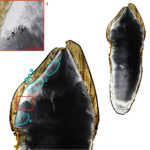Homo sapiens already reached northwest Europe more than 45,000 years ago and lived alongside Neanderthals
The arrival of Homo sapiens in cold northern latitudes took place several thousand years before Neanderthals disappeared in southwest Europe
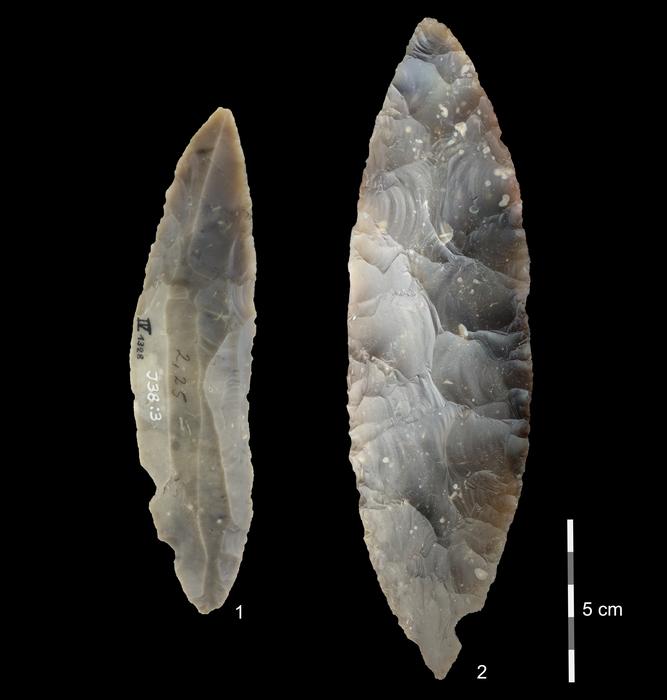
An international research team reports the discovery of Homo sapiens fossils from the cave site Ilsenhöhle in Ranis, Germany. Directly dated to approximately 45,000 years ago, these fossils are associated with elongated stone points partly shaped on both sides (known as partial bifacial blade points), which are characteristic of the Lincombian-Ranisian-Jerzmanowician (LRJ). This archaeological technocomplex is temporally situated between the Neanderthal-associated Middle Palaeolithic and the Upper Palaeolithic made by Homo sapiens. Further, at Ranis, the LRJ also contains bifacial leaf points, which are fully worked across both sides, and have been interpreted, by some researchers as evidence for a link with local Neanderthals. The new discoveries now document the earliest known Homo sapiens fossils in Central and northwest Europe and reveal for the first time the makers of the LRJ. The partial bifacial blade points found at Ranis – one of the main type-sites of the LRJ – have also been discovered at other localities across Europe, from Moravia and eastern Poland across to the British Isles, and can now be linked to an early arrival of small groups of Homo sapiens in northwest Europe several thousand years before Neanderthals disappeared in southwest Europe.
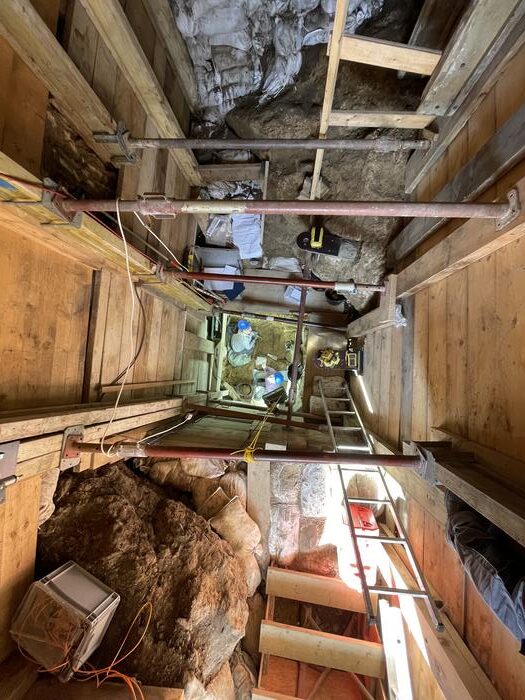
The three published studies describe the Homo sapiens fossils from Ilsenhöhle at Ranis and their associated context (Mylopotamitaki et al.), the diet and lifeways of these first pioneers (Smith et al.), and the environmental conditions they faced in Central and NW Europe (Pederzani et al.).
“The Ranis cave site provides evidence for the first dispersal of Homo sapiens across the higher latitudes of Europe. It turns out that stone artefacts that were thought to be produced by Neanderthals were in fact part of the early H. sapiens tool kit. This fundamentally changes our previous knowledge about this time period: H. sapiens reached northwestern Europe long before Neanderthal disappearance in southwestern Europe”,
says Jean-Jacques Hublin, Professor at the Collège de France, Paris and emeritus director at the Max Planck Institute for Evolutionary Anthropology in Leipzig, Germany.
Eight metre sequence re-excavated for the first time since the 1930s
An international research team led by Jean-Jacques Hublin (Max Planck Institute for Evolutionary Anthropology and Collège de France, Paris), Shannon McPherron (Max Planck Institute for Evolutionary Anthropology), Tim Schüler (Thüringisches Landesamt für Denkmalpflege und Archäologie) and Marcel Weiss (Friedrich-Alexander-Universität Erlangen-Nürnberg and Max Planck Institute for Evolutionary Anthropology) re-excavated Ranis between 2016 and 2022.
The aims were to locate remaining deposits from the 1930s excavation, clarify the stratigraphy and chronology of the site, and identify the makers of the LRJ. At the bottom of the eight metre deep sequence, the researchers discovered layers containing the LRJ.
“The challenge was to excavate the full eight metre sequence from top to bottom, hoping that some deposits were left from the 1930s excavation. We were fortunate to find a 1.7 metre thick rock the previous excavators did not get past. After removing that rock by hand, we finally uncovered the LRJ layers and even found human fossils. This came as a huge surprise, as no human fossils were known from the LRJ before, and was a reward for the hard work at the site”,
says Marcel Weiss of the Friedrich-Alexander-Universität Erlangen-Nürnberg and the Max Planck Institute for Evolutionary Anthropology.
Thousands of bone fragments
Thousands of highly fragmented pieces of bone were recovered at the site.
“Zooarchaeological analysis shows that the Ranis cave was used intermittently by denning hyaenas, hibernating cave bears, and small groups of humans,”
explained zooarchaeologist Geoff Smith from the University of Kent and the Max Planck Institute for Evolutionary Anthropology.
“While these humans only used the cave for short periods of time, they consumed meat from a range of animals, including reindeer, woolly rhinoceros, and horses” said Smith. “Although the bones were broken into smaller pieces, they were exceptionally well preserved and allowed us to apply the latest cutting-edge methods from archaeological science, proteomics and genetics,” explained Smith.
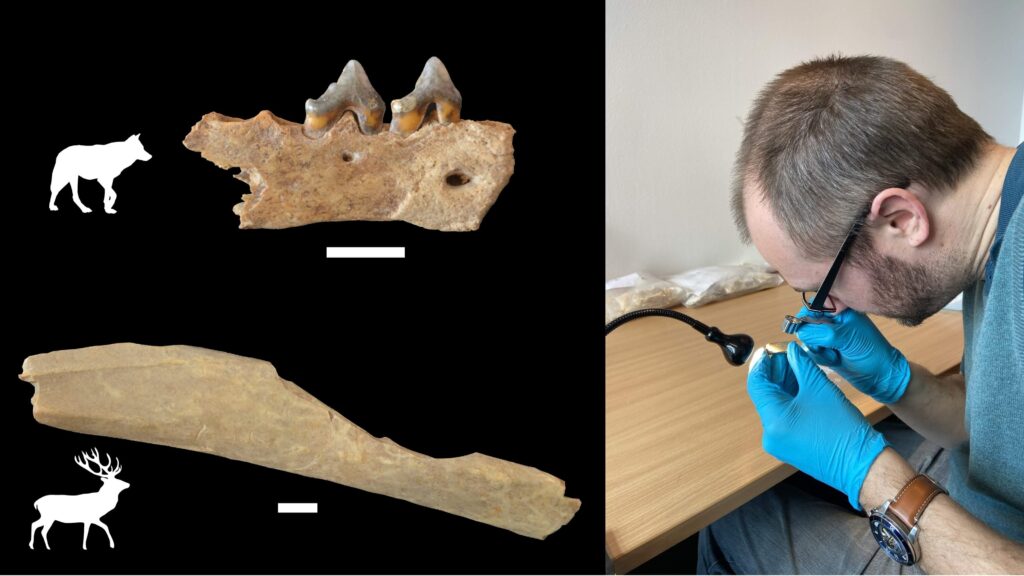
The first human bones from Ranis were identified using palaeoproteomics
The researchers used the proteins extracted from the morphologically unidentifiable bone fragments to identify the animal and the human remains found in the LRJ layers.
“Palaeoproteomics is a relatively new tool to perform taxonomic identifications of previously unidentifiable skeletal remains recovered from archaeological sites. At Ranis, this enabled us to identify the first human remains associated with the LRJ layers, which were then analysed further with the latest methods in ancient DNA, radiocarbon dating, and stable isotope analysis.”
says Dorothea Mylopotamitaki, a former PUSHH-Marie Sklodowska-Curie Actions Doctoral Fellow at the Collège de France and the Max Planck Institute for Evolutionary Anthropology.
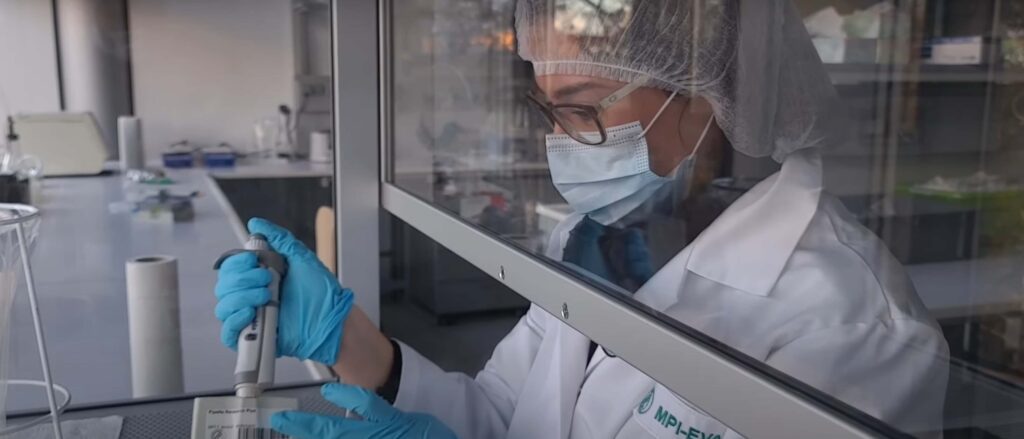
In addition to these new excavations, the team also undertook new analyses of the bone fragments from the old Ranis collection (1932 to 1938 excavations), which are curated and stored at the State Office for Heritage Management and Archaeology Saxony-Anhalt in Germany. This included a study where the bones were examined one by one to potentially identify human remains.
“This painstaking work was rewarded by the discovery of several new human bones,” said Hélène Rougier, a palaeoanthropologist at California State University Northridge. “Finding human remains mixed with animal bones that had been stored for almost a century was an unexpected and fantastic surprise,” she added. Further work on these collections is ongoing by Hélène Rougier and researchers from the State Office for Heritage Management and Archaeology Saxony-Anhalt and highlights the enormous value of museum collections.
DNA sequencing showed that the bones were Homo sapiens
Once the 13 human skeletal remains from both the old and new excavations were identified, DNA was extracted from these fossils and analysed.
“We confirmed that the skeletal fragments belonged to Homo sapiens. Interestingly, several fragments shared the same mitochondrial DNA sequences – even fragments from different excavations. This indicates that the fragments belonged to the same individual or were maternal relatives, linking these new finds with the ones from decades ago,”
says Elena Zavala, a Miller Postdoctoral Research Fellow at the University of California, Berkeley, and Max Planck Institute for Evolutionary Anthropology.
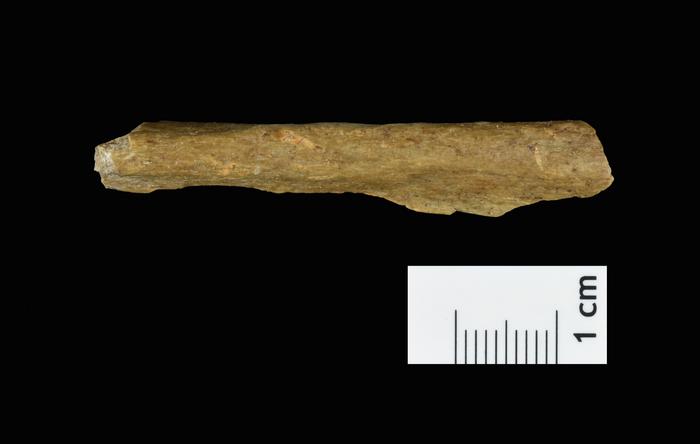
Another important goal was to obtain DNA from the sediments at the site, especially from the LRJ layers. Therefore, in addition to their search for human bone fragments, the team also extracted ancient mammalian DNA from sediment samples to complete the zooarchaeological analysis. Additionally, nuclear DNA analyses are ongoing in collaboration with Arev Sümer at the Max Planck Institute for Evolutionary Anthropology.
Homo sapiens reached northwest Europe as early as 47,500 years ago
Radiocarbon dating was used to understand when humans occupied the cave. Homo sapiens bones from both the 1930s and 2016 to 2022 excavations were directly dated using very small amounts of bone to preserve the material for further analyses. The dates show that these individuals were some of the earliest Homo sapiens to inhabit Europe.
The team also carried out radiocarbon dating of animal bones from different layers of the site to reconstruct the site’s chronology. They focused on bones with traces of human modifications on their surfaces, linking the dates to human presence at the cave.
“We found very good agreement between the radiocarbon dates from the Homo sapiens bones from both excavation collections and with modified animal bones from the LRJ layers of the new excavation, making a very strong link between the human remains and LRJ. The evidence suggests that Homo sapiens were sporadically occupying the site from as early as 47,500 years ago,”
says Helen Fewlass, an EMBO Postdoctoral Fellow at the Francis Crick Institute, London, and formerly of the Max Planck Institute for Evolutionary Anthropology.
Homo sapiens had the capacity to adapt to harsh climatic conditions
Stable isotope analyses on animal teeth and bones allow insights into the climatic conditions and environments that the pioneering groups of Homo sapiens encountered around Ranis. The team combined information from a broad range of different stable isotope ratios and was able to show that a very cold continental climate and open steppe landscapes, similar to those found in Siberia or northern Scandinavia today, prevailed during the time of the LRJ, and climatic conditions cooled even further throughout the LRJ occupations of Ranis.
“This shows that even these earlier groups of Homo sapiens dispersing across Eurasia already had some capacity to adapt to such harsh climatic conditions,”
says Sarah Pederzani from the University of La Laguna and the Max Planck Institute for Evolutionary Anthropology, who led the palaeoclimate study of the site.
“Until recently it was thought that resilience to cold-climate conditions did not appear until several thousand years later, so this is a fascinating and surprising result. Perhaps cold steppes with larger herds of prey animals were more attractive environments for these human groups than previously appreciated.”

This comprehensive study, integrating archaeological excavation, morphological and proteomic taxonomic identification, mitochondrial DNA analysis, radiocarbon dating of newly excavated archaeological material and of human remains, zooarchaeology, and isotope analysis marks a significant milestone in understanding the initial incursions of Homo sapiens into Europe north of the Alps during the Middle to Upper Palaeolithic transition. Furthermore, the team found that Homo sapiens ventured into Europe under severe cold climatic conditions.
Moving in small groups, they shared their environment and sites with large carnivores, like hyenas, and they manufactured elaborately crafted leaf-shaped stone tools.
“The results from the Ilsenhöhle in Ranis fundamentally change our ideas about the chronology and settlement history of Europe north of the Alps. It is especially exciting that we now have the oldest H. sapiens here in Thuringia, Germany”, says Tim Schüler of the Thüringisches Landesamt für Denkmalpflege und Archäologie.
Press release from the Max Planck Institute for Evolutionary Anthropology – MPI-EVA
———————————————————————————————————————————————————-
Neanderthals and humans lived side by side in Northern Europe 45,000 years ago
Genetic analysis of bone fragments from German archaeological site proves that modern humans reached northern Europe not long after they emerged from Africa
A genetic analysis of bone fragments unearthed at an archaeological site in central Germany shows conclusively that modern humans — Homo sapiens — had already reached Northern Europe 45,000 years ago, overlapping with Neanderthals for several thousand years before the latter went extinct.
The findings establish that the site near Ranis, Germany, which is known for its finely flaked, leaf-shaped stone tool blades, is among the oldest confirmed sites of modern human Stone Age culture in north central and northwestern Europe.
The evidence that Homo sapiens and Homo neanderthalensis lived side by side is consistent with genomic evidence that the two species occasionally interbred. It also feeds the suspicion that the invasion of Europe and Asia by modern humans some 50,000 years ago helped drive Neanderthals, which had occupied the area for more than 500,000 years, to extinction.
The genetic analysis, along with an archaeological and isotopic analysis and radiocarbon dating of the Ranis site, are detailed in a trio of papers appearing today in the journals Nature and Nature Ecology and Evolution.
The stone blades at Ranis, referred to as leaf points, are similar to stone tools found at several sites in Moravia, Poland, Germany and the United Kingdom. These tools that are thought to have been produced by the same culture, referred to as the Lincombian–Ranisian–Jerzmanowician (LRJ) culture or technocomplex. Because of previous dating, the Ranis site was known to be 40,000 years old or older, but without recognizable bones to indicate who made the tools, it was unclear whether they were the product of Neanderthals or Homo sapiens.
The new findings demonstrate that “Homo sapiens made this technology, and that Homo sapiens were this far north at this time period, which is 45,000 years ago,” said Elena Zavala, one of four first authors of the Nature paper and a Miller Research Fellow at the University of California, Berkeley. “So these are among the earliest Homo sapiens in Europe.”
Zavala was a Ph.D. student at the Max Planck Institute for Evolutionary Anthropology (MPI-EVA) in Leipzig in 2018 when she first began working on the project, which was a major effort spearheaded by Jean-Jacque Hublin, former director of the institute and a professor at the Collège de France in Paris.
Bones from maternal relatives?
Zavala conducted the genetic analysis of hominid bone fragments from the new and deeper excavations at Ranis between 2016 and 2022 and from earlier excavations in the 1930s. Because the DNA in ancient bones is highly fragmented, she employed special techniques to isolate and sequence the DNA, all of it mitochondrial DNA (mtDNA) that is inherited solely from the mother.
The bone fragments were initially identified as human through analysis of bone proteins — a field called paleoproteomics — by another first author, Dorothea Mylopotamitaki, a doctoral student at the Collège de France and formerly of MPI-EVA.
By comparing the Ranis mitochondrial DNA sequences with mtDNA sequences obtained from human remains at other paleolithic sites in Europe, Zavala was able to construct a family tree of early Homo sapiens across Europe. All but one of the 13 Ranis fragments were quite similar to one another and, surprisingly, resembled mtDNA from the 43,000-year-old skull of a woman discovered in a cave at Zlatý kůň in the Czech Republic. The lone standout grouped with an individual from Italy.
“That raises some questions: Was this a single population? What could be the relationship here?” Zavala said. “But with mitochondrial DNA, that’s only one side of the history. It’s only the maternal side. We would need to have nuclear DNA to be able to start looking into this.”
A transitional site between Middle and Upper Paleolithic
Zavala specializes in the analysis of DNA found in long-buried bones, on bone tools and in sediment. Her search through sediment from various levels of the Ranis excavation turned up DNA from a broad array of mammals, but none from hominids. The analysis, combined with morphological, isotopic and proteomic analysis of bone fragments, paints a picture of the environment at that time and of the diet of both humans and animals that occupied the cave over the millennia.
The presence of reindeer, cave bear, woolly rhinoceros and horse bones, for example, indicated cold climatic conditions typical of steppe tundra and similar to conditions in Siberia and northern Scandinavia today, and a human diet based on large terrestrial animals. The researchers concluded that the cave was used primarily by hibernating cave bears and denning hyenas, with only periodic human presence.
“This lower-density archaeological signature matches other Lincombian–Ranisian–Jerzmanowician sites and is best explained by expedient visits of short duration by small, mobile groups of pioneer H. sapiens,” according to one of the papers published in Nature Ecology and Evolution.
The Ranis site, called Ilsenhöhle and located at the base of a castle, was initially excavated mainly between 1932 and 1938. The leaf points found there were eventually assigned to the final years of the Middle Paleolithic period — between about 300,000 and 30,000 years ago — or the beginning of the Upper Paleolithic, which begins around 50,000 years ago.
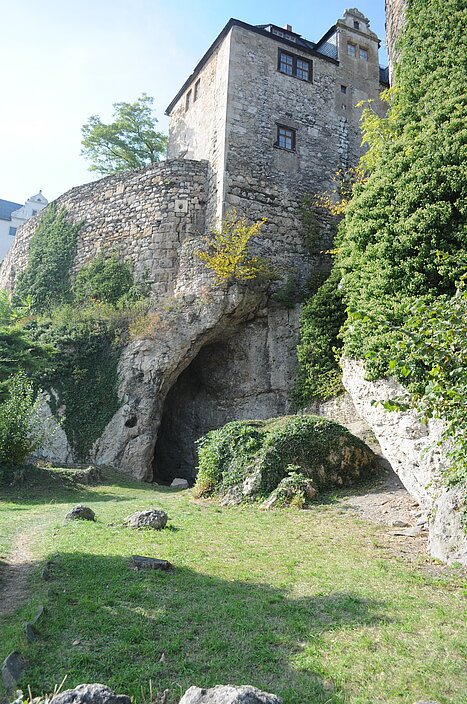
Because of the importance of the Ranis site for understanding the LRJ technocomplex and the transition from the Neanderthal-associated late Middle Paleolithic to the modern human Upper Paleolithic in central Europe, Hublin and his team decided to reexcavate the site using modern tools of archaeology.
The new excavations extended to bedrock, about 8 meters below the surface, and involved removing a rock — likely fallen from the cave ceiling — that had halted the previous excavation. Here, Hublin’s team uncovered chips from flint tools and a quartzite flake consistent with the LRJ technocomplex. Subsequent proteomic analysis of thousands of recovered bone chips confirmed that four were from hominids. Of bone chips uncovered during the 1930s excavations, nine were from hominids.
Zavala’s DNA analysis confirmed that all 13 bone fragments came from Homo sapiens.
A revised settlement history of Northern Europe
The team also carried out radiocarbon dating of human and animal bones from different layers of the site to reconstruct the site’s chronology, focusing on bones with traces of human modifications on their surfaces, which links their dates to human presence in the cave.
Among other co-authors of the Nature paper are co-first author Marcel Weiss of the Friedrich-Alexander-Universität Erlangen-Nürnberg and Shannon McPherron of MPI-EVA, who co-led the Ranis excavation with Hublin, Schüler and Weiss. Zavala, in addition to being co-first author of the Nature paper, co-authored the two papers in Nature Ecology and Evolution.
The excavations and much of the subsequent analysis were financially supported by the Max Planck Society.
Press release from University of California, Berkeley, by Robert Sanders.
Bibliographic information:


